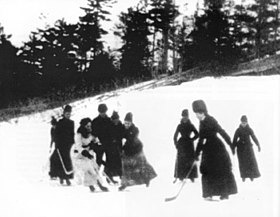| Main page | Categories & Topics | WikiProjects & Things you can do |
The ice hockey portal

Ice hockey, referred to simply as hockey in Canada, the United States, and most of Europe including Finland, Sweden, Russia and the Czech Republic, is a team sport played on ice. It is one of the world's fastest sports, with players on skates capable of going high speeds on natural or artificial ice surfaces. Though played on six continents, ice hockey, as a participatory and as a spectator sport, is most popular in nations in which the climate is sufficiently cold as to permit natural, long-term seasonal ice cover; Canada, the Czech Republic, Finland, Slovakia, Sweden, Russia, and the United States have dominated international competition, claiming 47 of the 48 gold and silver medals awarded in the men's and women's competitions at the Olympic Winter Games.
Ice hockey is one of the four major North American professional sports, represented at the highest level by the National Hockey League. It is the official national winter sport of Canada, where seven of the 32 NHL franchises are based; Canadian-born players, though, outnumber American-born players in the NHL by a factor of three (30 per cent, additionally, come from outside North America).
The sport is played on a hockey rink. During normal play, there are six players, five positional players and one goaltender, per team on the ice at any time, each of whom is on ice skates. The objective of the game is to score goals by shooting a hard vulcanized rubber disc, the puck, into the opponent's goal net, with the goal nets placed at opposite ends of the rink. The players may control the puck using a long stick with a blade that is commonly curved at one end. Players may also generally redirect the puck with any part of their bodies, but the kicking of the puck into the goal is prohibited.
Featured article

The history of the National Hockey League began with the demise of its predecessor league, the National Hockey Association (NHA), in 1917. After unsuccessfully resolving disputes with Eddie Livingstone, owner of the Toronto Blueshirts, executives of the three other NHA franchises suspended the NHA, and formed the National Hockey League (NHL), replacing the Livingstone team with a temporary team in Toronto, the Arenas. The NHL's first quarter-century saw the league compete against two rival major leagues—the Pacific Coast Hockey Association and Western Canada Hockey League—for players and the Stanley Cup. The NHL first expanded into the United States in 1924 with the founding of the Boston Bruins, and by 1926 consisted of ten teams in Ontario, Quebec, the Great Lakes region, and the Northeastern United States. At the same time, the NHL emerged as the only major league and the sole competitor for the Stanley Cup; in 1947, the NHL completed a deal with the Stanley Cup trustees to gain full control of the Cup. The NHL's footprint spread across Canada as Foster Hewitt's radio broadcasts were heard coast-to-coast starting in 1933. (more...)
Quotes
| “ | Red ice sells hockey tickets. | ” |
| — Bob Stewart | ||
Featured Lists
Selected image

Ice hockey has traditionally been played predominantly by men, the history of the women's game dates similarly to that of the men's. Women's hockey became more popular over the latter half of the 20th century as both a participant sport and a spectator sport.
Did you know ...

- ...that HC Dynamo Moscow were the sole club from the Russian Hockey Super League (RHSL) to reach the 1998 European Hockey League final?
- ...that the Saint Mary's University (pictured) (Halifax, Nova Scotia) Huskies reached the final of the Canadian Interuniversity Sport (CIS) ice hockey championship in four consecutive seasons between 1970 and 1973?
- ...that the Middlebury College Panthers, have won five women's ice hockey national championships?
- ...that Jim O'Brien played defense before switching in university to "play as a power-forward centre-ice man"?


